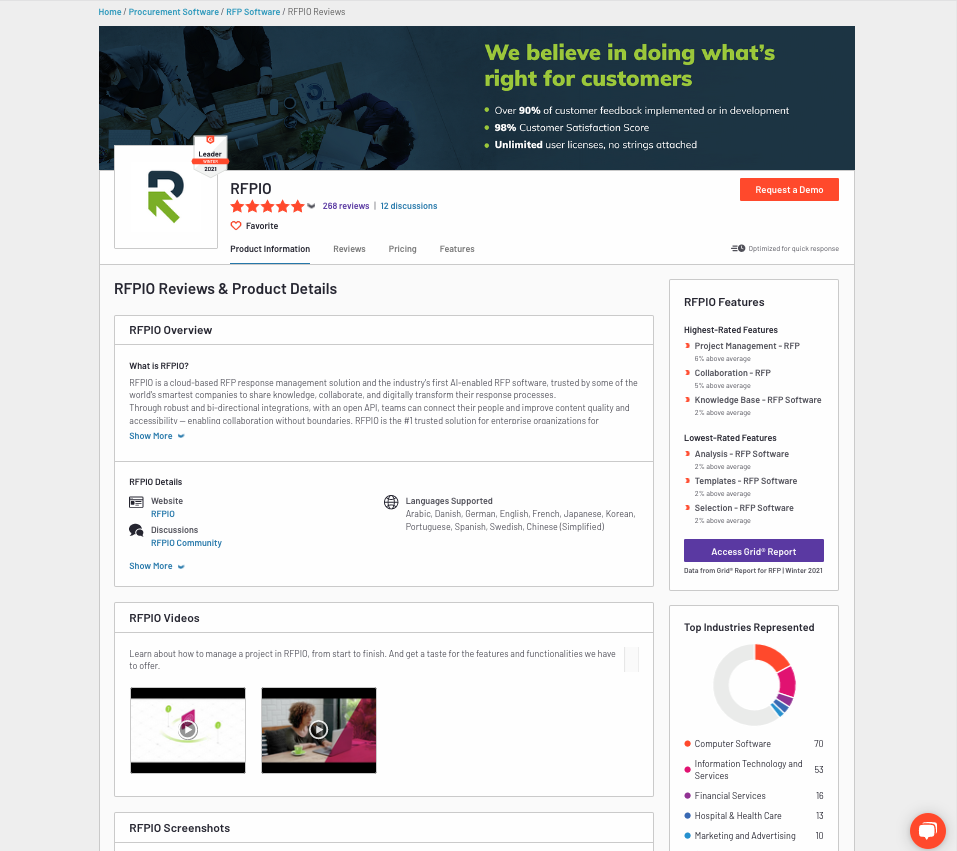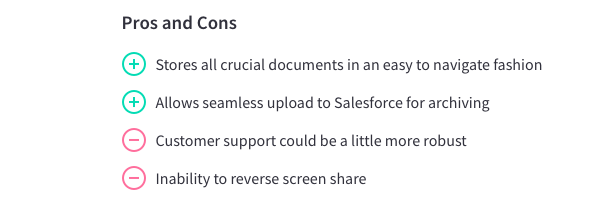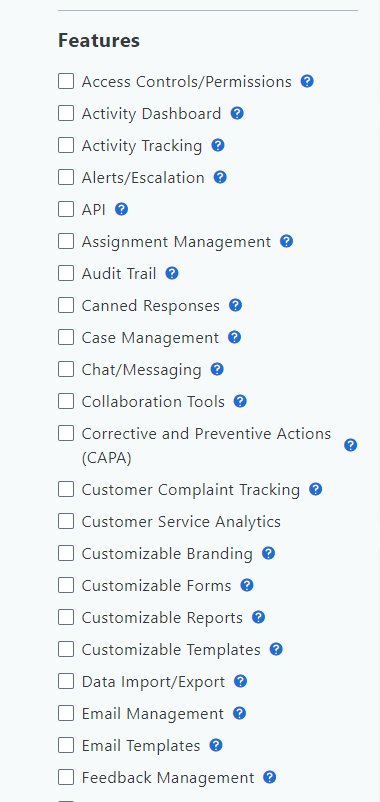How to Leverage SaaS Customer Review Sites
Last updated: May 13th, 2024
Most B2B SaaS companies realize that review sites like G2, Capterra, and TrustRadius heavily influence buying decisions, yet few companies know how to effectively leverage these sites to drive sales.
The common strategy for optimizing a brand profile on a review site is encouraging happy customers to leave positive reviews and responding quickly to negative reviews.
Earning positive reviews is certainly important, but there are plenty of ways to leverage the trust these review sites have already established with their audience to build trust and get your brand in front of high value prospects.
Additionally, these sites offer a goldmine of competitive intelligence that you can use to inform your other marketing efforts, your sales pitch, and even the product itself.
In this article, we’ll discuss these four specific ways you can leverage review sites:
- Improve your positioning by reading your competitors’ reviews (as well as your own!).
- Generate content ideas for content marketing and sales enablement material.
- Level up your PPC strategy.
- Improve your SEO presence.
We’ll also provide some tactical strategies to optimize your brand profile on review sites to improve your brand image on these review sites and maximize the value they offer.
We help B2B SaaS companies maximize their growth through demand generation, SEO and paid media. If you’d like to learn more how we can help your business, get your Free Marketing Plan here.
If you prefer, you can also listen to this post:
Leveraging Customer Review Sites to Refine Your Positioning
The idea of positioning is often vague. This makes it hard for SaaS companies to understand what it is and where to start. But in essence, positioning is simply answering the following three questions for the market you’re targeting:
- Who’s your product for?
- What’s the problem it solves?
- How does your product work differently than the competition?
When defining your SaaS company’s positioning, review sites can be the ideal place to begin. After all, they’re packed full of customer insights about you and your competition.
To organize the information you can gather from them, you can use our SaaS Positioning Canvas. It’s a simple, 7-step framework that SaaS companies can lean on while articulating their positioning.

To illustrate how you could collect and organize insights from review sites in this framework, let’s use a real SaaS company as an example. Loopio is a request for proposal software that happens to be one of our long-term clients.
If Loopio wanted to refine their positioning relative to their competition, we would start by gathering intel on a site like G2. We’d simply search for Loopio and take note of what G2 recommends as possible alternatives.

From that list, we can do a deeper analysis of each business, starting first with how each one describes and positions themselves.
In this case, let’s take a closer look at RFPIO. It appears they’ve taken full advantage of G2, providing it with necessary details about who they are and what they do. They’ve even included a few demo videos, screenshots, and white papers that demonstrate their expertise in the RFP space.

But beyond the information that RFPIO’s given, we can drill down even further by examining what their customers have said about them. G2 has customers segment their reviews based on three different questions:
- What do you like best?
- What do you dislike?
- What problems are you solving with the product? What benefits have you realized?
In particular, the answers to the second question could be the most valuable. What we’d do is recommend Loopio to take note of all the comments reviewers made to that question. With those in mind, Loopio could then choose to highlight positioning based on their competitors’ reported weak points.
In doing so, they can increase the relevancy of their positioning and compel more prospects to choose their product instead — especially if the weak points selected are of particular importance to customers.
In addition, they increase the chances that RFPIO customers seeking alternatives due to those weaknesses will choose Loopio instead.
Leveraging Customer Reviews for Content Marketing and Sales Enablement
Many SaaS companies make the mistake of creating content for the sake of creating content.
Yet you’ve probably noticed that some of your content drives significantly more conversions than other pieces of content.
This is because the content that converts answers questions quality prospects are searching.
Therefore, it makes sense to only create content that answers questions your ideal prospects are actively searching for.
Fortunately, review sites are a goldmine of commonly asked customer questions and G2 even tells you directly the problems people were struggling with that they use the tool to solve.
For example, if Birdeye is your competitor, you can tell that customers use it to improve the quality and quantity of Google reviews. Therefore, create content about how to improve Google reviews (and incorporate your brand’s features as part of the solution in the content).
 You can also look at the reviews of your competitors and identify common pain points with their products.
You can also look at the reviews of your competitors and identify common pain points with their products.
Then, use that information to identify key differentiators of your product and discuss those differentiators in your content.
For example, if you notice that most people complain that the competitor’s product lacks a particular feature that your product offers, you can improve the effectiveness (and conversion rate) of your content by discussing that feature in your content and highlighting that this feature or functionality is not common across all products in your category.
To illustrate how you can do this, let’s say you do some digging on TrustRadius into one of your competitors.
In your research, you notice that one of the common cons that customers note is about customer support. You also recognize a pattern of dissatisfaction around pricing as well as their long-learning curve.

Therefore, be sure to highlight that your product does offer reverse screen share in your blog content and highlight the benefits of having that feature.
You can apply these same principles to your competitor comparison pages.
For example, let’s say that you’re a company that provides marketing analytics software for agencies. You visit G2 and TrustRadius and find out that customers of one of your competitors often wish they were better at the following:
- More robust reporting, specifically when it comes to building and formatting. Customers would also appreciate if your competitor made it easier to send reports, too.
- Less friction and more seamless ways to integrate other related software platforms.
- Better ways to handle client billing.
Ask yourself: “Are these areas that my software has stronger features and functionality?” If the answer is yes, then emphasize the how and why in your comparison pages pitting you against your competition.
Leveraging Customer Reviews to Fine-tune Your PPC Ads Strategy
People visiting review sites like G2 and Capterra are likely already product or solution aware, making them high value prospects. Therefore, advertising on these sites is a great opportunity to get your brand in front of new high value prospects. It’s also a great opportunity to keep your brand top of mind with MQLs and move them through the buying cycle faster.
The problem with targeting any high-value audience is that it will also be highly competitive and expensive.
Therefore, review sites can be a great place to run PPC ads and provide incremental growth to your paid media strategy, but you can quickly burn through thousands of dollars in ad budget if you don’t have a strategic approach to advertising on these platforms.
Following common PPC best practices is always a good start to optimizing your review site campaigns, but here are a few other optimizations we make to boost ROI.
Fully Optimize and Update Your Profile:
Make sure your brand’s description clearly communicates the problems your product solves, and that the category settings are correct. It’s also important to include up-to-date screenshots and videos of your product.
Reviews:
If your profile doesn’t have any reviews, you’re wasting your ad budget as users on review sites want to read unbiased reviews.
If you only have a handful of reviews, launch a review generation campaign before running ads. For example, you can send regular surveys to audiences and leave a review link at the end of each survey.
Bid Strategy:
We’ve been advised by Capterra reps to aim our bids toward getting the second position instead of the first, as aiming for the second position tends to yield a better CPA.
So how much should you budget to spend on these platforms? In general, we’ve found that a budget of $15,000 per month tends to produce the best results, though even as low as $5,000 per month can work.
However, it really depends on the category. Reach out to their reps before you start running ads, as they can give you a CPC bid estimate before you start advertising for the top three positions to get a sense of how much you’ll need to spend to make your ads relevant.
Dedicated Landing Page:
Where are you sending prospects after they click on your ad? Ideally, build a dedicated landing page that is congruent with their experience on Capterra.
As prospects are researching different solutions, this landing page should highlight the key differentiators of your product and clearly communicate your unique positioning within the market.
We have a competitor comparison page framework that highlights how to tastefully and effectively differentiate your SaaS product in a competitive market.
Additional Insights Review Sites Provide
Given the high cost of advertising on review sites, they’re an excellent addition to your paid media strategy, but they won’t make or break your PPC strategy.
Anecdotally, we’ve also found that low ACV SaaS products tend to perform better than high ACV products targeting enterprises, but we recommend all of our clients set aside a small ad budget to test this channel.
Review sites like Capterra and G2 allow you to advertise to categories rather than keywords, so it’s an excellent resource to discover adjacent categories you may not have considered targeting on other platforms.
To clarify, let’s continue with our Loopio example from above for whom we run ads on Capterra. In addition to their primary categories of “Proposal Management” and “RFP”, we’ve also discovered other potential opportunities in categories related to security intake and questionnaires.
This information is useful because it provides us with additional intelligence for expanding our targeting to reach new audiences on other PPC platforms.
Leveraging Customer Reviews to Boost Your SEO Strategy
Review sites like Capterra and G2 tend to rank very well for bottom of the funnel keywords targeting high intent prospects, like “best (category) software.”
Therefore, these review sites are a prime opportunity to earn quality brand exposure. This is particularly helpful for brands in highly competitive industries where it’s currently unrealistic to rank organically for bottom of the funnel, high purchase intent keywords.
In fact, when search engines notice your brand mentioned on these review sites, it can help boost your website’s authority and organic presence in search results. This is particularly true for review sites that allow you to send a backlink to your website.
From a prospect’s perspective, a third party brand mention is also often more trustworthy and powerful than self promotion.
On the other hand, if prospects already know that your brand exists and are considering it as a potential solution, a lack of presence on these review sites is a red flag that could cause them to question your brand’s quality and legitimacy.
Tips To Optimize Your Review Profile For Conversions
Earning more positive reviews is clearly one of the most important factors for building a strong brand profile on a review site, but there are plenty of other opportunities to maximize conversions from your brand profile on review sites.
Ensure Brand Information Is Consistent Across All Review Sites
To encourage prospects to take the next step, the first profile optimization tip is to ensure information is consistent across all review sites as well as your own website. This is obviously critical for converting viewers, but it’s also important from an SEO standpoint. If search engines notice that your links are inconsistent or broken, it can negatively impact your website’s authority.
Here’s a quick checklist you can use to ensure your profile is up to date and well optimized:
- Are the links working and sending prospects to relevant pages?
- Are the screenshots and videos the same across all review sites and up to date?
- Is the messaging and positioning consistent across all review sites?
- Have you filled out each piece of real estate within the profile?
Optimize The Copy To Communicate Your Product’s Differentiators
Your brand is positioned directly next to your competitors on these review sites, many of which offer similar features and solve similar problems. So the copywriting itself must communicate a compelling reason why prospects should learn more about your product rather than your competitors’ products.
Many product descriptions are generic in an attempt to attract everyone, so it’s often difficult for prospects to discern how one product is different from another.
So an excellent opportunity to stand out is to optimize the copywriting within your product description to highlight your product’s key differentiators and benefits rather than covering generic functionalities that both your product and all of your competitors offer.
In fact, we have an entire resource that articulates the exact framework we use to create competitor comparison pages that effectively articulate how we differentiate our product from the competition.
Define Your Ideal Target Audience
Another pro tip to help your brand stand out is to articulate who your product serves. Many SaaS companies have very general messaging in an attempt to attract everyone and ultimately attract nobody. Instead, we purposefully state who we serve to attract the right prospects and repel unqualified prospects.
For example, we have a cybersecurity client that exclusively serves enterprise clients, so we clearly articulate that the product is an enterprise solution in its description across all review sites. This not only repels unqualified prospects, but it also helps the product stand out to ideal prospects.
Highlight Features Your Product Offers That Are Important To Prospects
A final pro copywriting tip we learned from a Capterra rep is to identify the feature filters offered and then discuss those features within the listing.
For example, one of the filters for this product is “audit trail.” Therefore, mention your audit trail feature in your product description and highlight any differentiators about that feature.

As you can see, the way you position your product via the copywriting is essential for capturing the attention of a prospect scrolling these review sites, so we encourage you to hire a professional copywriter to write the descriptions for each product description to maximize conversions.
Next Steps To Take Action And Leverage Customer Review Sites
Up until now, you’ve likely focused most of your energy on reputation management or getting more positive reviews. These objectives are important, but they’re not the only ways to leverage review sites for your SaaS business.
Instead, focus also on using them for competitive intelligence and implementing the tactics we discussed in this article. To recap, they were:
- Positioning
- Content Ideation for Marketing and Sales
- PPC Advertising Campaigns
- SEO and Organic Presence
Most SaaS companies tend to overlook these opportunities in spite of the value they can add. But taking advantage of the insights you gather from review sites can earn you a leg up against your competition.
If you want more help leveraging customer reviews, reach out to our team today for your Free Marketing Plan and we can help uncover specific opportunities within both your review strategy and general marketing strategy.
What you should do now
Whenever you’re ready…here are 4 ways we can help you grow your B2B software or technology business:
- Claim your Free Marketing Plan. If you’d like to work with us to turn your website into your best demo and trial acquisition platform, claim your FREE Marketing Plan. One of our growth experts will understand your current demand generation situation, and then suggest practical digital marketing strategies to hit your pipeline targets with certainty and predictability.
- If you’d like to learn the exact demand strategies we use for free, go to our blog or visit our resources section, where you can download guides, calculators, and templates we use for our most successful clients.
- If you’d like to work with other experts on our team or learn why we have off the charts team member satisfaction score, then see our Careers page.
- If you know another marketer who’d enjoy reading this page, share it with them via email, Linkedin, Twitter, or Facebook.